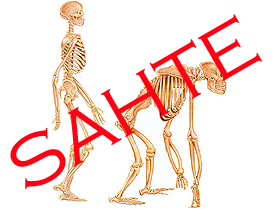Human beings walk upright on two legs in a way not encountered in any other life form. (See Bipedalism,) Some other animals possess a limited ability to walk on two legs. Mammals such as the bear and monkey can move on their hind legs for short periods of time, such as when they're reaching for something to eat). However, they have stooped skeletons and normally walk on four legs.
According to the classifications made in the imaginary human family tree, it is claimed that apes classified under the names Australopithecus and Homo habilis walked upright. However, through research into their fossil skeletons in question by a great number of scientists, the invalidity of these claims has been revealed.
The claim of bipedalism is one that evolutionist paleontologists such as Richard Leakey and Donald Johanson have supported for decades. Wide-ranging research into Australopithecus specimens by two world famous anatomists, Lord Solly Zuckerman of Britain and Professor Charles Oxnard of the USA, showed that these beings were not bipedal, but moved in the same way as present-day apes. Despite being an evolutionist himself, Lord Zuckerman, who for 15 years examined the bones of these creatures with a team consisting of five experts, backed by the British government, concluded that Australopithecus was an ordinary species of ape and very definitely did not walk upright.150
Finally in 1994, Liverpool University's Fred Spoor and his team carried out wide-ranging studies in order to arrive at a definitive conclusion regarding the Australopithecus skeleton. During that research, the inner ear structures of Australopithecus fossils were examined. An organ known as the cochlea determines the body's position relative to the ground in the inner ears of human beings and other complex life forms. That organ's function is similar to the bubble level used to maintain level surfaces by carpenters.. In order to determine whether the creatures portrayed as ancestors of man walked upright, Fred Spoor investigated this particular organ. The comparison analyses made on the balance centers revealed that apes classified as Homo habilis did not walk upright, but were bent forward.152
150. Solly Zuckerman, Beyond The Ivory Tower, New York: Toplinger Publications, 1970, pp.75-94.
151. Charles E. Oxnard, "The Place of Australopithecines in Human Evolution: Grounds for Doubt," Nature, Vol 258, p. 389.
152. Fred Spoor, Bernard Wood, Frans Zonneveld, "Implication of Early Hominid Labryntine Morphology for Evolution of Human Bipedal Locomotion," Nature, Vol. 369, June 23, 1994, pp. 645-648.


